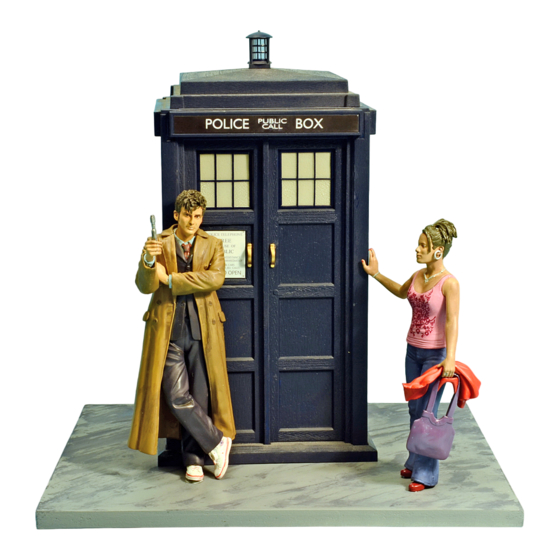AIRFIX Doctor Who Welcome Aboard Інструкції зі збирання та фарбування - Сторінка 9
Переглянути онлайн або завантажити pdf Інструкції зі збирання та фарбування для Ігрові набори та обладнання для дитячих майданчиків AIRFIX Doctor Who Welcome Aboard. AIRFIX Doctor Who Welcome Aboard 11 сторінок.

Powderbrushing – The process of enhancing a
model's appearance using the powdered pigment
from a Watercolour Pencil. Powderbrushing can
enhance the look of clothing but is primarily used to
create natural skin tones, stubble and makeup.
Powderbrushing is achieved by rubbing the tips of
Watercolour pencils on sandpaper (180 Grit is
recommended). Carefully create small heaps of
powdered pigments which you can blend with a
clean brush. Once the correct tone has been
achieved brush the model with the pigment using
light, quick strokes and 'fix' the end result with a
clear lacquer. It is essential that the brush you use
for mixing the powders is not in any way damp or
the powder will revert to Watercolour paint.
The TARDIS
Add subtle shading to the base colour of the TARDIS
exterior by Washing darker tones over the panelled
areas of the model. Add a second wash to intensify
the darker areas of blue specifically around the
edges of each panel. To paint authentic looking
weathering on the TARDIS start by adding light grey
to the base blue paint and Drybrush the surface.
Drybrush the panels at least twice more adding light
grey to the mix to produce progressively lighter
tones. The first coat of Drybrush should be used to
emphasise wood grain all over the exterior and
subsequent layers need to be built up around the
worn areas of the keyhole, door edges and each of
the corners. Finally add subtle shading by
Powderbrushing beige and brown darker tones
around the base and lower panels.
For the best results on the interior use basic flat
colours as the foundation. Add a touch of dark
brown to the base colours and wash over the
console edging and it's supporting struts. Build up
several layers of a dark sandy coloured wash on the
material at the top of the central column. The look of
the floor around the central column is achieved by
painting a light grey base tone and Drybrushing it
with red-brown. The pipework seen through the
superstructure is painted using a base coat of light
grey with a dark grey wash. To complete the look of
the model; paint in the details on the control panels
with your finest brush.
The Doctor's Head
1 Start with a base coat of light flesh colour. Mix a
very slightly warmer wash of your base flesh tone
16
using a tiny amount of reddish brown. Run the wash
in the ears, around nostrils and eyes. Add dark
brown to the wash and paint in the nostrils.
2 Paint the eyes by laying down a base coat of
light grey then using a wash of a 'pinker' flesh (add
red to the base flesh colour), using this mix paint in
the corners of the eyes and under the eye lids. Paint
a dark brown, filled, circle for the foundation of
each Iris and add a ring of a much lighter orangey
brown to the Iris before adding a black pupil and
light grey highlight. Paint the upper eye lashes with
a dark brown and the lower eyelashes with a fleshy
grey (add black/brown to the base flesh tone).
Complete the eye with gloss varnish. For the
eyebrows Overbrush in base hair colour and the
Drybrush a lighter tone of the same colour.
3 Paint the lips with a lighter, pinker version of the
base flesh tone. Create a deeper brown/red/
burgundy wash for the lips to bring out the detail
and emphasize the 'gap' between the lips.
4 Create a greyer version of the base flesh tone
using the Powderbrushing technique and brush the
beard line to create stubble.
5 The final stage is to Powderbrush some life into
the flesh. Using a very, very slightly darker version
of the base flesh tone create a skin shader (the
Watercolour pigment mix would be; light grey,
orange, yellow and brown). Brush the powder into
the detail of the face (e.g. around the nose, mouth,
chin, neck, ears and eyes). Create a pinker version
of the Powderbrush skin shader and brush the
cheeks, in the corners of the eyes and around the
nostrils and Adams Apple.
6 Paint hair with a base coat of mid-brown followed
by a darker brown wash – finish the look with a
light dry brush of a brown which should be slightly
lighter than the base hair tone.
The Doctor's Body
Paint the body using flat even coats of paint. Add
subtle shading by Powderbrushing darker tones into
the creases of the coat and suit. Paint parallel
stripes outwards (and inwards) from two stripes
painted down the centre of each leg remembering
that a stripe will almost never continue across a
seam line. For authentic detailing use
gloss varnish on the buttons and coat
17
